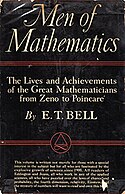Men of Mathematics

Men of Mathematics is a book on the history of mathematics written in 1937 by the mathematician E.T. Bell. After a brief chapter on three ancient mathematicians, the remainder of the book is devoted to the lives of about forty mathematicians who worked in the seventeenth, eighteenth and nineteenth centuries. The emphasis is on mainstream mathematics following on from the work.
To keep the interest of readers, the book typically focuses on unusual or dramatic aspects of its subjects' lives. Men of Mathematics has inspired many young people, including a young John Forbes Nash Jr., to become mathematicians. It is not intended as a rigorous history, includes many anecdotal accounts, and presents a somewhat idealised picture of mathematicians, their personalities, research and controversies.
Contents
- Zeno (Fifth Century BC), Eudoxus (408–355 BC), Archimedes (287?–212 BC)
- Descartes (1596–1650)
- Fermat (1601–1665)
- Pascal (1623–1662)
- Newton (1642–1727)
- Leibniz (1646–1716)
- The Bernoullis (17th and 18th Century )
- Euler (1707–1783)
- Lagrange (1736–1813)
- Laplace (1749 1827)
- Monge (1746–1818), Fourier (1768–1830)
- Poncelet (1788–1867)
- Gauss (1777–1855)
- Cauchy (1789–1857)
- Lobachevsky (1793–1856)
- Abel (1802–1829)
- Jacobi (1804–1851)
- Hamilton (1805–1865)
- Galois (1811–1832)
- Sylvester (1814–1897), Cayley (1821–1895)
- Weierstrass (1815–1897), Sonja Kowalewski [sic] (1850–1891)
- Boole (1815–1864)
- Hermite (1822–1901)
- Kronecker (1823–1891)
- Riemann (1826–1866)
- Kummer (1810–1893), Dedekind (1831–1916)
- Poincaré (1854–1912)
- Cantor (1845–1918)
